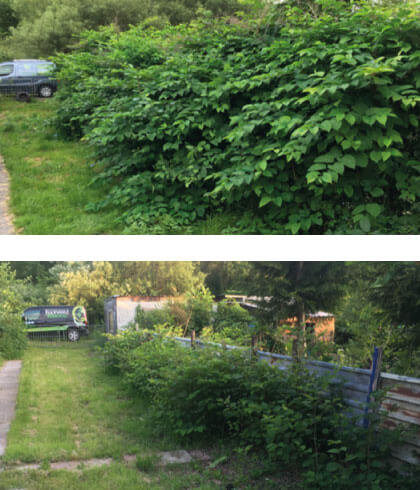Control Methods
There are different control and removal methods for Japanese Knotweed and the one used will depend on different factors including; the size of the Knotweed infestation, if it is growing amongst plants and vegetation you want to keep, if it is close to a water source or if it is at a development site where work needs to be started quickly.
All our Japanese Knotweed treatment methods are endorsed by the Environment Agency Codes of Practice and the industry trade body (The Property Care Association) and they will be tailored to suit you as the client and the property or land where the Knotweed or bamboo is growing. We are happy to consider a staggered payment schedule for any work that does not involve a 3rd party, who may require evidence of pre-payment in full from the outset (mortgage lenders as an example).

GET STARTED TODAY
Before & After

Bund / Stockpiling
The bund / stockpiling method is a quick and cost-effective method used for development sites when construction needs to start quickly and the site is big enough for the Knotweed infested soil to be stockpiled temporarily and treated.
Creating a bund or stockpiling is essentially a combined treatment method of stem injection or foliar application, followed by excavating the underground material and removing the soil and material to a different section of the site to allow the development to start. The soil is then stockpiled in an area on site that doesn’t need to be built or worked on immediately, also known as a non-critical area. The Knotweed is then encouraged to grow in the stockpile so it is ready for the subsequent herbicide treatment. Procedures are put in place to ensure that the knotweed infested soil is not allowed to spread to otherwise clean areas of the site or from the stockpiling.
This method is much quicker than conventional herbicide application methods, saving the developer or landowner several years. It can be done at any point when the knotweeds growth is above ground so the area can be identified and it is particularly useful on building or development sites so work can start at the original infestation area.
Cell Burial / Root Barrier
Providing there is adequate space on site, creating a cell burial or utilising a root barrier will avoid the significant cost of transporting the infested Knotweed soil and waste to a licensed landfill site. The Knotweed material is buried and usually encapsulate within a geo-membrane as per industry standards.
Root barriers can be installed both vertically (normally when there is a risk of cross-boundary contamination) and horizontally. Root barriers are used to physically control and prevent the spread of the Knotweed. This method can be used on both construction sites and residential properties if there is a suitably sized area for it to be buried.
These methods are generally suited for development sites when building and construction work needs to start quickly.
Excavation & Removal Off-Site
Excavation & disposal at landfill should only be used as a last resort when other remediation methods aren’t viable. There is a duty of care required under the Environmental Protection Act (EPA) 1990 for transporting and disposing of Knotweed, whilst only certain landfill sites will accept Japanese Knotweed infested soil or material. The financial burden on this remediation method is usually quite significant due to the inevitability of plant cost, haulage, landfill tax to name a few.